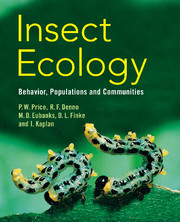Book contents
- Frontmatter
- Contents
- Preface
- Acknowledgments
- Part I Introduction
- Part II Behavioral ecology
- Part III Species interactions
- 4 Plant and herbivore interactions
- 5 Lateral interactions: competition, amensalism and facilitation
- 6 Mutualisms
- 7 Prey and predator interactions
- 8 Parasite and host interactions
- Part IV Population ecology
- Part V Food webs and communities
- Part VI Broad patterns in nature
- Glossary
- References
- Author Index
- Taxonomic Index
- Subject Index
- Plate section
- References
4 - Plant and herbivore interactions
from Part III - Species interactions
Published online by Cambridge University Press: 05 June 2012
- Frontmatter
- Contents
- Preface
- Acknowledgments
- Part I Introduction
- Part II Behavioral ecology
- Part III Species interactions
- 4 Plant and herbivore interactions
- 5 Lateral interactions: competition, amensalism and facilitation
- 6 Mutualisms
- 7 Prey and predator interactions
- 8 Parasite and host interactions
- Part IV Population ecology
- Part V Food webs and communities
- Part VI Broad patterns in nature
- Glossary
- References
- Author Index
- Taxonomic Index
- Subject Index
- Plate section
- References
Summary
In their classic paper entitled “Butterflies and plants: a study in coevolution,” Ehrlich and Raven (1964) envisioned an “arms race” between plants and herbivores, whereby each player exerted reciprocal selective pressure on the other that resulted in evolutionary change. Thus, the arms race between plants and herbivores emphasizes an ongoing reciprocal interplay with plants erecting defenses, herbivores breaking defenses with novel offenses, plants countering with new defenses and so on through evolutionary time (Mitter et al. 1991 , Herrera and Pellmyr 2002, Thompson 2005). Moreover, “breakthroughs” in plant defense or herbivore offense are thought to create “adaptive zones” that promote speciation, lineage diversification and thus the generation of biodiversity. However, an apparent dilemma arises because plants in general have longer generation times and lower recombination rates than their insect herbivores (and especially plant pathogens), which should hinder their ability to keep pace in the evolutionary arms race (Whitham 1983). Yet, plants have clearly done so.
While the concepts of arms races and coevolution are useful as an overall theme in this chapter, we do not wish to imply that coevolution is a general phenomenon in the interaction between plants and insect herbivores. Strong cases can be developed for coevolution among mutualists (Chapter 6) and parasite–host relationships (Chapter 8), but there is a shortage of sound evidence that insect herbivores have impacted plant traits in a coevolutionary manner (Futuyma and Agrawal 2009).
- Type
- Chapter
- Information
- Insect EcologyBehavior, Populations and Communities, pp. 99 - 183Publisher: Cambridge University PressPrint publication year: 2011
References
- 2
- Cited by



